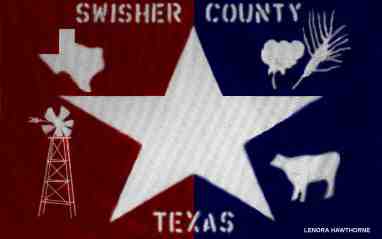Maps
(Click on an image to see the actual size)
 Location in Texas |
 Surrounding Counties |
 The 21 Communities of Swisher County (1940) Source: Division of Land Economics WPA Project, 1940, pg 21 Booklet can be found at the Swisher County Library |
 The Communities of Swisher County (similar map published 1990 in Interments in Swisher County, Texas and Vicinity) Courtesy of the Tule Creek Genealogical Society |
Swisher County Map (off site) |
1895 Swisher County Map (off site) |
| Texas County Boundries (off site – animated) |
Texas Historical Counties (off site – select date) |
Center Plains
Center Plains is on Farm Road 145 nine miles west of Kress in southwestern Swisher County. Originally there were two separate communities, Auburn and Center Plains, in the area. The first local school was organized in 1893 and was located six miles west of Kress. The school occupied one other spot before in 1916 reaching its final location near what is now the site of the Center Plains Gin. The community of Auburn, to the north, was founded sometime before 1900 and had a school, a grocery store, and a blacksmith shop. In 1922 the two communities merged their schools and constructed a red brick schoolhouse. Many community affairs and church functions were held at this building. In 1947 the Center Plains school district was merged with the Kress district, but the old brick building continued to be used for various community functions. It, the gin, two stores, and surrounding farms made up the Center Plains community in the 1980s. In 2000 the population was forty.
BIBLIOGRAPHY: Swisher County Historical Commission, Windmilling: 101 Years of Swisher County History (Dallas: Taylor, 1978).
H. Allen Anderson
Handbook of Texas Online, s.v. “,” http://www.tsha.utexas.edu/handbook/online/articles/CC/hrcbg.html
Claytonville
Claytonville is on Farm Road 145 ten miles east of Kress in southeastern Swisher County. In the early 1950s M. C. Clayton, a cotton grower, moved his ginning business to the area from Bailey in Fannin County. He then built a grocery and cafe for his employees. Soon the Clayton Gin became a favorite gathering place for area farmers, and for several years the company hosted a community barbecue just before harvest. The gin was one of the first to compost gin waste and return it to the fields. In 1962 a Baptist church was established at Claytonville. In 1984 Claytonville reported a population of 116 and six businesses. The population was still 116 in 1990 and 2000.
BIBLIOGRAPHY: Swisher County Historical Commission, Windmilling: 101 Years of Swisher County History (Dallas: Taylor, 1978).
H. Allen Anderson
Handbook of Texas Online, s.v. “,” http://www.tsha.utexas.edu/handbook/online/articles/CC/hlc68.html
Happy
Happy, on U.S. Highway 87 in northern Swisher County, derived its name from nearby Happy Draw, so named because cowboys were elated to find water there. In 1891 Hugh Currie established a homestead and post office on the trail by the draw, and a stagecoach exchange station also operated at this location. In 1906 the Santa Fe Railroad extended its line south from Canyon and bypassed Happy. Promoters laid out a town by the tracks two miles to the west, and their efforts attracted settlers from the Midwest. At the new site, Plains Lumber and Grain Company was the first business to be established, J. F. White opened the first general store, and the Happy News began publication. By 1907 the post office had been moved to the new town, and a one-room dwelling had been rented for the first school. The First State Bank of Happy was chartered in 1908. Telephone service was ushered in, originally from a switch at the Currie farm and later from a telephone exchange in town. The first brick building was Mose Wesley’s auto repair shop, erected in 1913. In August 1925 Happy was incorporated with P. J. Neff as mayor and Tom Bandy and William F. Miller as commissioners. During the 1920s new school facilities were built and a volunteer fire department was organized. By 1940 the town reported a population of 576, and two grain elevators constituted the skyline. In 1984 Happy had a population of 674 and twenty-seven businesses, most of them related to farming. The number of businesses dropped to fourteen and the residents to 588 by 1990. In 2000 the population had increased to 647, and there were forty-eight businesses in the town. Happy uses the slogan “the town without a frown.”
BIBLIOGRAPHY: Austin American-Statesman, August 5, 1989. Lana Payne Barnett, and Elizabeth Brooks Buhrkuhl, eds., Presenting the Texas Panhandle(Canyon, Texas: Lan-Bea, 1979). Swisher County Historical Commission, Windmilling: 101 Years of Swisher County History (Dallas: Taylor, 1978). Fred Tarpley, 1001 Texas Place Names (Austin: University of Texas Press, 1980).
H. Allen Anderson
Handbook of Texas Online, s.v. “,” http://www.tsha.utexas.edu/handbook/online/articles/HH/hlh21.html
Thanks to Judy (Whitley-Crotty) Fox for these great pictures of Happy.
| Catholic Church Front | Catholic Church Back | City Hall | City Limits & Population Sign |
| Historical Marker | Post Office | Water Tower | Welcome To Happy Sign |
More photos of happy located here.
http://www.texasescapes.com/TexasPanhandleTowns/Happy-Texas.htm
Kaffir
Kaffir is a rural community and loading station on the Santa Fe Railroad between Tulia and Happy in north central Swisher County. Kaffir is dominated by the huge grain elevator and loading bin beside the tracks near U.S. Highway 87 (Interstate 27) and apparently was named for the strain of grain sorghum (usually spelled kafir) produced in the area. In 1906 a school district was organized. The rural school house was moved frequently until the 1920s, when a permanent building was constructed just north of the elevator. This structure was also used as a community church and public meeting place. A store and filling station were also built beside the highway. In the 1940s the Kaffir school district was partitioned between the districts of Happy and Tulia. Although the local Home Demonstrationqv Club continued to use the school building for a few more years, it was eventually abandoned and razed. Besides the elevator, only the old coal house remained on the site in 1984.
BIBLIOGRAPHY: Swisher County Historical Commission, Windmilling: 101 Years of Swisher County History (Dallas: Taylor, 1978).
H. Allen Anderson
Handbook of Texas Online, s.v. “,” http://www.tsha.utexas.edu/handbook/online/articles/KK/htk1.html
Kress
Kress, on U.S. Highway 87 in southern Swisher County, was originally named Wright, after a local rancher and preacher, when it was founded in 1890. It had a post office, a general store, and a school and was on the stage line from Canyon to Plainview. When the Pecos and Northern Texas Railway came through the county in 1906, the store and post office were moved two miles southwest to the present site and were named for another pioneer settler, George H. Kress. C. F. Sjogren, a local immigrant farmer and land broker, encouraged settlement of the area. In 1909 the local Commercial Club, headed by Sjogren’s land company, published a booklet that advertised the town’s advantages as a trade center and listed its population as close to 500. Although that figure may have been exaggerated, by that time Kress did have mercantile stores, drugstores, lumberyards, wagonyards, hotels, two banks, a telephone exchange, a telegraph office, and a railroad depot. The first school at Kress had opened in 1907. In 1915 the first garage and filling station was erected, a grain elevator was built, and a weekend rodeo was organized for local recreation. During the history of Kress, the location of the main highway through town has shifted at least twice, compelling the business district to shift likewise. By the late 1920s the town had electricity and natural gas utilities, and in 1941 a butane plant was established; it has since closed. In 1953 the town elected to incorporate with the mayor-council form of city government.qv By then it had a population of more than 650. In 1955 a volunteer fire department was organized, and a new municipal water system was completed. The old banks closed during the Great Depression,qv and Kress was without a bank until the opening of the Kress National Bank in 1963. In the 1980s Kress remained an active agribusiness center with an affiliated school, a city park, five churches, and thirty businesses. The Missouri Beef Packers plant, which in the 1980s reportedly had the world’s largest beef kill capacity under one roof, is on the highway south of Kress. The town reported a population of 783 in 1984. In 1991 Kress reported 759 residents and forty-two rated businesses.
BIBLIOGRAPHY: Amarillo Daily News, October 17, 1953. Swisher County Historical Commission, Windmilling: 101 Years of Swisher County History (Dallas: Taylor, 1978).
H. Allen Anderson
Handbook of Texas Online, s.v. “,” http://www.tsha.utexas.edu/handbook/online/articles/KK/hlk15.html
Tulia
Tulia, the county seat of Swisher County, is on U.S. Highway 87 forty-nine miles south of Amarillo in the central part of the county. Its site was originally on the acreage of the Tule Ranch division of the JA Ranch.qv In 1887 a post office was established in James A. Parrish’s dugoutqv on Middle Tule Draw nine miles west of what is now the site of Tulia. Evidently the name Tule, after the nearby creek, had been selected for this post office, but at some point a clerk’s error changed the name to Tulia. Parrish served as postmaster until 1889, when W. G. Conner took over and the post office was moved nine miles east to the homestead he had established in 1887. Also in 1889, a one-room schoolhouse was built; it doubled as a church. Eleven pupils attended school there that first year. Conner’s section was chosen for the county seat when Swisher County was organized in 1890. He donated land for the courthouse, the school, and the city park, which is named after him, and ran a wagonyard in town. W. F. Wright began publication of the first newspaper, the Staked Plains Messenger, and by September a two-story frame courthouse had been constructed. Scott Thacker opened the first general store, and Mrs. S. E. Butts ran a boardinghouse. In 1897 the Methodists constructed the first church building.
By 1900 Tulia was prospering as a stopping point for freight-wagon traffic en route to the railheads of Colorado City and Amarillo. In 1892 the Tulia Standardbegan publication, and in 1909 the Tulia Herald appeared. Telephone lines had been run from Tulia to Amarillo by 1901. The Tulia National Bank (later the First National Bank of Tulia) was chartered in 1902. A booming new era began with the extension of the Santa Fe line to Tulia in December 1906. With it came more settlers, many of whom spent their first night at the Hotel Tulia, which was for years a city landmark. A brick schoolhouse was built in 1907, and in 1909 a three-story domed brick courthouse was built. That same year the city was incorporated, with W. G. Conner as mayor. By 1910 Tulia had a population of 1,216. The next year, bonds were voted to purchase, construct, and maintain a waterworks system and a light plant. Between 1910 and 1920 Tulia became known as the City of Windmills, because of the proliferation of windmills in the vicinity. During the 1920s the main streets were paved with bricks, and a new school building was constructed. An original Ozark Trail marker still stands on the square as a reminder that Tulia was a major stop on that historic route. In 1945 William Kirk Hulsey constructed a landing strip north of town; it was enlarged into a municipal airport in 1964.
Tulia has remained a center for farming and agribusiness activities. In the mid-1980s local industrial plants manufactured products such as clothing and farm implements, and there were four large cattle-feeding enterprises nearby. A modern county courthouse, built in 1962, stood in the center of the square, and local residents were also served by Swisher Memorial Hospital and by the Swisher County Memorial Building, which housed the library and the chamber of commerce offices. The Swisher County Museum displayed paintings and pioneer relics, and featured a log cabin that was originally a line camp for the JA Ranch. In the 1980s nineteen churches, six public schools, and a radio station also served the community. Tule Lake and Country Club, northeast of town, included a Girl Scout camp and also provided recreational facilities, as did Mackenzie Lake on the Swisher-Briscoe county line. The annual picnic and rodeo, held in Tulia in mid-July, included an old-timers’ reunion. The Swisher County Fair in September was also an annual event. In addition, Tulia was known as the home of the singing Otwell Twins, David and Roger, who gained national notice in the late 1970s on Lawrence Welk’s television show. The population of Tulia decreased from 5,294 in 1970 to 5,033 in 1984, when the town reported 110 businesses. In 1990 it had 4,699 residents.
BIBLIOGRAPHY: Lana Payne Barnett and Elizabeth Brooks Buhrkuhl, eds., Presenting the Texas Panhandle (Canyon, Texas: Lan-Bea, 1979). Swisher County Historical Commission, Windmilling: 101 Years of Swisher County History (Dallas: Taylor, 1978). Fred Tarpley, 1001 Texas Place Names (Austin: University of Texas Press, 1980).
H. Allen Anderson
Handbook of Texas Online, s.v. “,” http://www.tsha.utexas.edu/handbook/online/articles/TT/hft1.html
Find out more about Tulia at TexasEscapes.com
Vigo Park
Vigo Park, on Farm Road 146 between Palo Duro and Tule canyons near the eastern border of Swisher County, was the result of a real estate venture in the early 1900s. In 1906 the Indiana-Texas Land Company, with headquarters in Terre Haute, Indiana, purchased 4,420 acres of land belonging to the JA Ranchqv and laid out a townsite. Company ads soon attracted many prospective homesteaders, who named the settlement after Vigo and Parke counties in Indiana. A post office, originally named Vio, was established in 1907. Its name was changed to Vigo Park in 1908, when the settlement had a combination general store and hotel, a blacksmith shop, a school, and a church. For a time the community also had a resident doctor. Irrigationqv wells and other farming innovations enabled Vigo Park residents to wrest a successful living from the soil. Livestock raising in the vicinity increased with the establishment of a feedlot in 1925. In 1940 the community recorded a population of forty. Though Vigo Park was never on a railroad as its founders had hoped, it remained an active rural community with two churches, a community center, a brick schoolhouse, and five businesses. Its post office was discontinued in 1958. By the 1980s brick houses had replaced most of the earlier wooden ones. In 1984 and 1990 Vigo Park reported a population of thirty-one.
BIBLIOGRAPHY: Arthur Hecht, comp., Postal History in the Texas Panhandle (Canyon, Texas: Panhandle-Plains Historical Society, 1960). Swisher County Historical Commission, Windmilling: 101 Years of Swisher County History (Dallas: Taylor, 1978).
H. Allen Anderson
Handbook of Texas Online, s.v. “,” http://www.tsha.utexas.edu/handbook/online/articles/VV/hnv15.html
Whitfield
Whitfield is in southeastern Swisher County. It began about 1891, when a store and post office opened, and was named for an early settler. A Baptist congregation began meeting that year at the home of J. M. Lovvorn, but it was not formally organized until 1900. At its peak the village had a Baptist and a Methodist church, each with a half-time pastor. The two-room Price school provided formal education for the area’s youth. Whitfield went into decline after the post office was discontinued in 1919. After the Price school was consolidated with the Kress school in 1948, the building was turned into a community center. The last official population listing for Whitfield was fifteen in 1947. In 1962 the Baptist church moved to nearby Claytonville. In the mid-1980s only a church and the community center remained.
BIBLIOGRAPHY: Arthur Hecht, comp., Postal History in the Texas Panhandle (Canyon, Texas: Panhandle-Plains Historical Society, 1960). Swisher County Historical Commission, Windmilling: 101 Years of Swisher County History (Dallas: Taylor, 1978).
Thelma Hall
Handbook of Texas Online, s.v. “,” http://www.tsha.utexas.edu/handbook/online/articles/WW/hrw24.html
Neighboring Counties
| Armstrong – Claude, Goodnight, Palo Duro Canyon, Washburn, Wayside. | Briscoe – Caprock Canyon State Park, Quotaque. |
| Castro – Hart, Nazareth, Summitt, Sunnyside. | Deaf Smith – Dawn, Ford, and Hereford. |
| Floyd – Aiken, Dougherty, Floydada, Lakeview, Lockney, South Plains. | Hale – Cotton Center, Hale Center, Halfway, Plainview, Seth Ward. |
| Lamb – Amherst, Bainer, Earth, Fieldton, Littlefield, Olton, Spade, Springlake, Sudan | Randall – Buffalo Lake National Wildlife Refuge, Lake Tanglewood, Mescalero Park, Palo Duro Canyon, Panhandle Plains Historical Museum, Ralph, Umbarger. |









